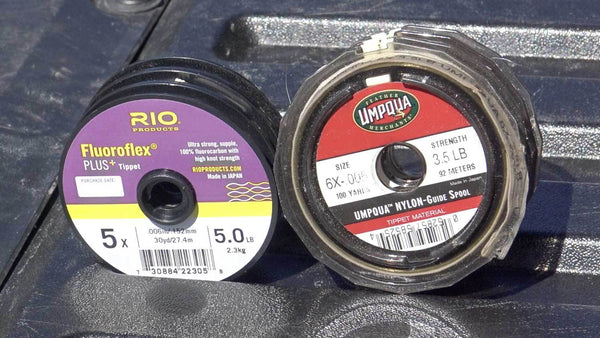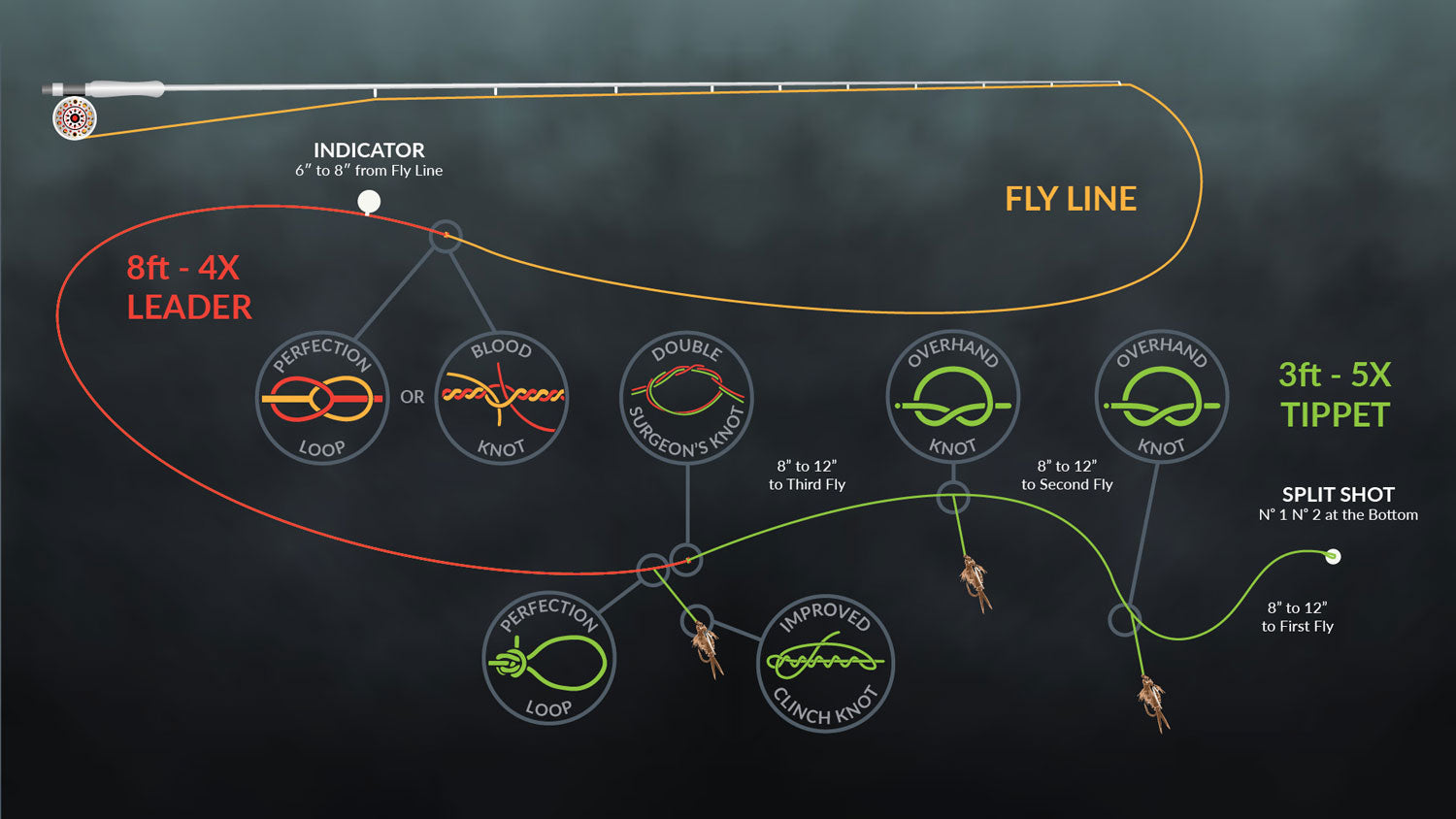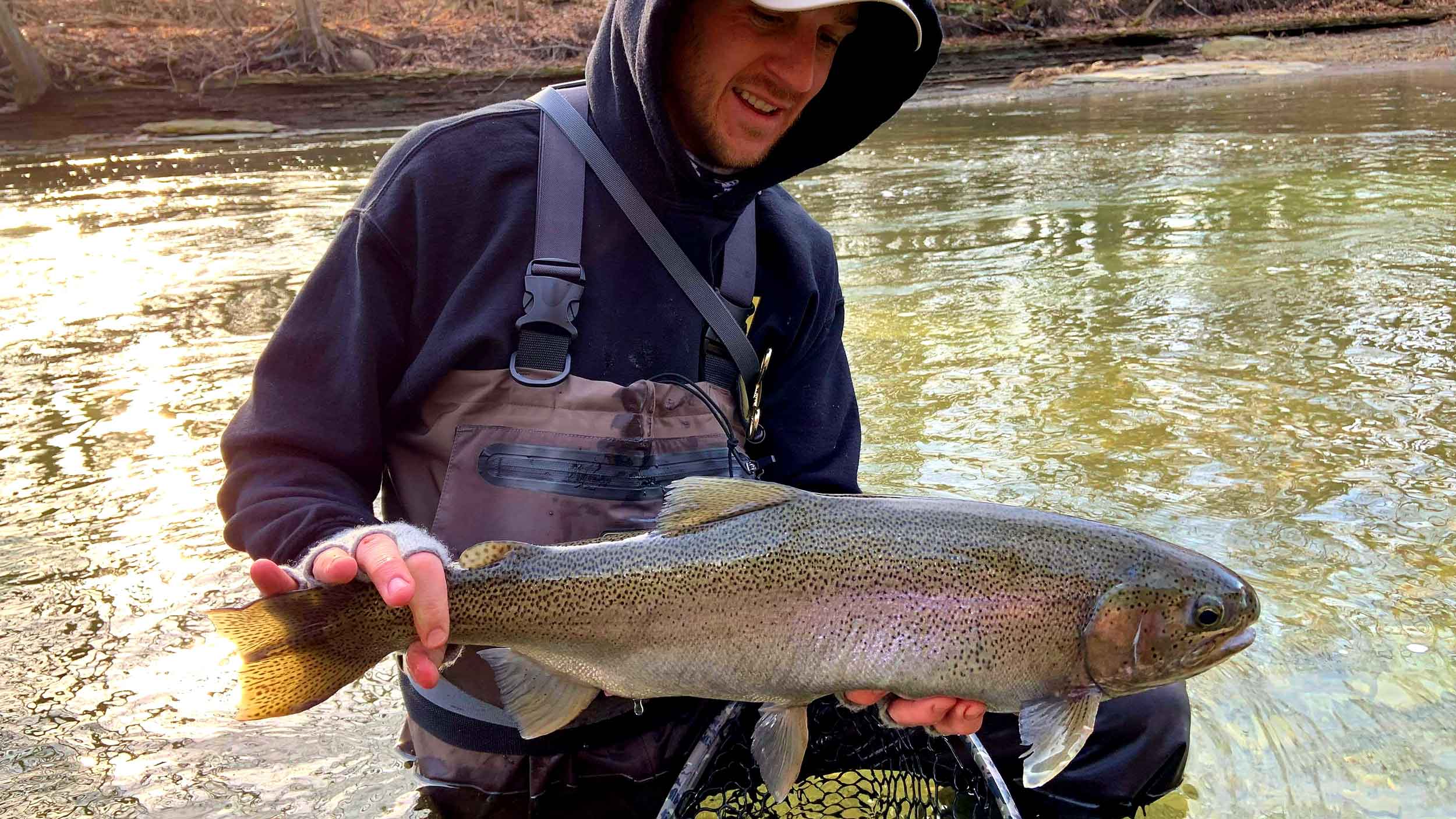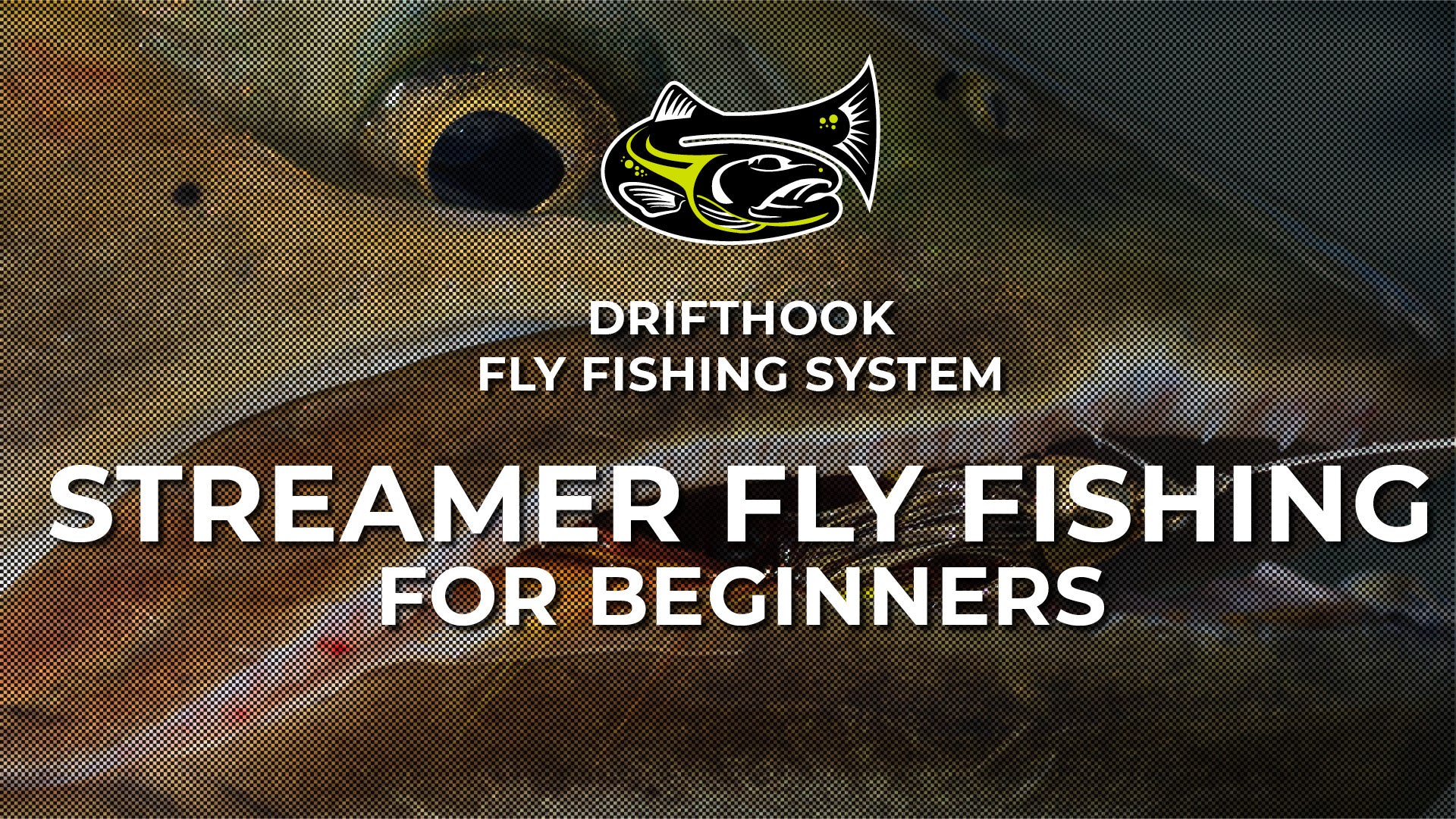
Are you dipping your toe into the water of fly fishing but feeling a bit overwhelmed by all the different types of gear and new terminology? Well, you’re not alone, here at Drifthook we want to help you discover the sheer joy that is fly fishing, without the jargon and unnecessary confusion, so here’s our quick guide to fly fishing with a dropper.
When you start fly fishing, you will typically fish with just one fly, which is known as a point fly and is attached to the end of your leader or tippet, however, as you start to gain a bit more experience you may decide to add a second or even third fly to your line. It's these additional flies that are called droppers.
Read on to find out more about why many anglers choose to fish with droppers, common mistakes you can make when fishing with droppers, and how to tie a dropper onto your leader yourself.
The Basics
Before we go any further and begin discussing the ins and outs of droppers, let's just take a moment to run through the basic setup of a fly rod. When we use terms such as 'leader' and 'tippet,' we want you to understand where on the fly-rod configuration we're referring to.
The Fly Rod
Your fly-rod is the rigid part of your setup and is responsible for helping you to cast, control your line, and land your fish.
The Fly Line
Through your fly-rod, you'll have your fly line, which is where the whole concept of fly-casting comes from. Your fly line is responsible for the length of your cast, and you'll find that there are many different types, but the main three to remember are floating lines, sinking lines and sinking tip lines.
The Leader
Attached to the end of your fly line, you'll have a leader, which put simply is the central transparent portion of the line that tapers down in thickness towards the end and puts some distance between the more visible fly-line and your flies. This portion is designed to make your line less conspicuous to the fish.

The Tippet
The tippet is the lightweight portion of material that attaches between your leader and your fly, the aim here is to have the strongest, yet most lightweight tippet possible, to stop the fish from noticing it.

The Point Fly
If you're using a one-fly method, then the point fly will attach to the end of your tippet, and your setup is complete.

Droppers
If you’re fishing with multiple flies, then your droppers (additional flies and their tippet line) will be tied to the leader, this is what we will be discussing in this post.

Why Do Anglers Use Droppers?
So we've already established that using a dropper simply means fishing with an additional fly or flies, and the reason many anglers prefer fishing with this technique is that when used correctly it can help to increase their chances of catching a fish, in some cases even enabling them to catch multiple fish at once!
You'll be forgiven for thinking that the primary benefit of using a dropper is a numbers game, but twice the flies doesn't necessarily mean twice the chance of catching a fish. Droppers also enable anglers to have greater control of their fishing setup, allowing them to control other variables that ultimately increase their chances of catching a fish. Some of the reasons why anglers choose to use droppers include:
Droppers enable anglers to use different types of fly, on one setup
Not all flies are created equal. Flies are designed to mimic insects and bait food at various stages of their lifecycle and encourage a fish to come up and take the hook. There's a lot of regional variation in the diets of fish across the world, and so, therefore, there are thousands of different fly designs.
If you're trying a new fishing spot and are unsure of which fly to use, then a dropper can enable an angler to hedge their bets and to try several patterns at once to see which works best in that environment.

Droppers enable anglers to cover different water depths.
Fish feed at different depths depending on their feeding habits, the time of year, and the food they're used to eating. Finding the feeding depth of the fish you are fishing for is crucial, and fishing using a dropper enables an angler to cover multiple feeding depths in one cast, allowing them to determine at which depth the fish are feeding fastest, thus increasing their chances of catching a fish.

Droppers can provide anglers with greater control.
It can be challenging to control the depth of a single fly, increasing the chances of an angler missing the optimum feeding depth. Using a dropper allows the angler to use a more buoyant fly as their point fly, which will then help them to control the depth of the dropper, keeping it in the desired feeding zone.
Droppers can be used with attractors.
Brightly colored or patterned flies are designed to draw fish in for a closer look, but more often than not, they fail to entice the fish in for a bite. A dropper can be used in conjunction with an attractor fly, providing a nearby tasty snack for the inquisitive fish to find.

Droppers can provide anglers with the chance to catch two fish.
Who doesn’t want to land two fish at once? Although trying to land two fish will prove extremely challenging, and more often than not you will lose one along the way, the opportunity to catch two fish at once is extremely attractive to many anglers, especially those who like a challenge. Droppers put more hooks on one line, therefore, increasing the chance of multiple bites. I dream of the day of landing two at once even though it has never happened for me.
When Wouldn’t An Angler Use A Dropper?
So far, we've put forward a pretty convincing argument for the use of droppers, but it's important to realize that they're not without their flaws too. Perhaps the single biggest reason why anglers tend to avoid using droppers is that they're notoriously prone to becoming tangled, especially in windy conditions.
Many anglers choose to use an alternative fishing method in windy weather to avoid constant dropper tangles. There are a few things you can do to minimize the chance of your droppers tangling, such as adjusting your casting stroke to open up your loop, but if the weather is against you, then you'll still find they get tangles every stroke or two.
Aside from increasing the chance of your line becoming a tangled mess, tying droppers to your leader also introduces weak points to the line, which can increase the likelihood of you experiencing the occasional snap off, which can also be frustrating.

How to Stop Your Droppers from Tangling
You may not be able to do anything about the wind, but there are a few other things that you can do to help reduce the chances of your droppers tangling during normal weather conditions.
- Use thicker line - Although the aim of fly fishing is usually to use the most natural-looking line as possible to maximize the chance of you catching more fish, sometimes you may need to compromise a little and use a slightly stiffer or thicker line to help reduce the chance of your droppers from tangling.
- Avoid bushy flies -Bushy, air-resistant flies are far more likely to get tangled than those that are a little more streamlined. Try to avoid big thick flies if you plan to use droppers.
- Tie in an additional overhand knot - The way you tie your droppers can also influence the likelihood of them becoming tangled. Try tying-in an extra overhand knot on the dropper to make it kick the line out at a right angle. This will help to stop it tangling but will also add in another knot, which adds a further weak point to the leader line.
- Use fewer droppers - You may think it goes without saying, but the more droppers you use, the more likely they are to become tangled. Try sticking to just one dropper if you find your line is continuously becoming tangled.
- Cast them differently - Ordinarily, when casting, anglers tend to aim for a narrow loop as it is more aerodynamic and can achieve a more impressive cast. With droppers on the line, however, anglers need to open up their casting loop to reduce the chance of their droppers colliding in the air. To open up your casting loop, you will need to adjust your casting stroke so that the rod dips lower at the back and forward casts. This technique can take some getting used to, so be prepared to have a few tangled droppers before you get it right.
How to Use Fly Fishing Droppers
So you're convinced that you want to give fishing with droppers a go but where on earth do you start? Don't panic, our friend, we've got you covered. Let's start with the basics.
How do you tie a dropper knot?
There are a few different types of knots that you can use for attaching droppers, and at first, they can all be a bit fiddly to get the hang of, so don't panic if it takes you a few practice runs to get them right. Rather than going straight in with a very fiddly, thin piece of nylon, practice first on a thicker part that is more easy to see and tie over a black piece of material. If you are finding it hard to see your line when out on the water, try placing it against a darker background like a shadow or foliage.
The three turn water knot
Although there are a couple of different knots that you could use, the simplest and by far the most widely used knot for attaching droppers to the leader, is the three-turn water knot. To tie a three-turn water knot, you want to take a length of your leader material, something around 18 inches long, and you want to run that parallel to your main leader line.
Next, tie a simple overhand loop as though you are tying a regular knot and pull both your leader and your dropper line through the loop three times. Once you have fed the lines through three times, then moisten the knot (a lick will do) and then pull it tight, and you'll see it tighten up nicely into a figure of eight shaped knots. Finally, cut the top section, the one facing toward the fly-line, as close to the knot as you can.
When it comes to learning knots, it’s always easier to get the hang of it by watching someone else tie one, so here’s a quick video of how to tie a three-turn water knot.
A quick hack
Although it's important to be able to tie a three-turn water knot properly, who doesn't like a hack if it helps to make things faster and easier? When it comes to three, four, or even five turn water-knots, sometimes it can get a bit fiddly pulling through long lengths of the line when you're down by the stream. If you're finding that things keep getting tangled or you're dropping lengths of your line, then give this hack a try. You'll find you have more control with the forceps, and it takes a lot less time to tie too.
Use the tag end of a tripple surgeons knot
This my favorite way of adding a dropper on to a nymph rig when I first set up my leader. While creating your tippet to leader connection, extend the tag end of your tippet by 6 to 8 inches. Then trim the end that is facing the point fly and use the other tag end as your connection point to your dropper. Rio Products has a great video explaining this technique below.
Tips for those who can’t tie knots
If you are having trouble with this not and are more comfortable with the other standard fly fishing knots, all you need to do to invest in a packet of leader or tippet rings. These rings are usually about 2mm to 5mm in diameter and are used to connect two pieces of line easier.
A packet will usually set you back a few dollars, but they can save you a lot of time if you have unwilling fingers, and you only need to know how to tie a straightforward grinner or uni knot. Before you give up on droppers altogether, give them a try.
How many droppers should I use?
If you're just starting then, we'd suggest you stick to a single point fly on the end of your leader and then only one dropper 18 to 24 inches further up the line. This will reduce the chance of your dropper tangling during casting and will let you get a feel for how to open up your casting loop without the added pressure of multiple droppers.
Once you've got the hang of a single dropper, then, by all means, experiment with a few more droppers but be wary that some fisheries have limitations on the number of flies you can use. So be sure to check the rules and regulations for the area you are fishing in first.
As a general rule, even the most experienced fly fishers don't tend to go beyond three droppers, we're not mackerel fishing here, and any more than that is likely to be more of a hindrance than a help.

How far apart should my droppers be?
If you want to spark a debate with a group of fly-fishers, then ask them how far apart their droppers should be - it's bound to get them talking! The distance anglers use between droppers can vary significantly, and the subject is hotly debated in the angling community. There isn't a right or wrong answer, and how far apart your droppers need to be will depend on preference, the weather, how good you are at casting, the line you are using, and even the condition of the water you're fishing in.
In general
On the expert length of the spectrum, some competition fishers can fish with leaders that are up to 25 feet long, though it's important to note their skill, experience, and the fact they tend to fish on still water. The average fly fisher will manage to fish using a leader no longer than 16 feet long, which is plenty long enough to comfortably fit two droppers spaced equidistant from the tip at 8 to 12 inches apart. You could even fit three droppers using the same spacing but give yourself more tippet to extend your leader.

On a river
If you're fishing on a river, then the spacing of your droppers can be reduced quite a lot, especially when fishing using smaller flies such as nymphs. One commonly used French nymphing technique involves placing two droppers around 18 inches apart and the bottom fly and an additional fly 24 inches from the bottom dropper. This spacing may seem quite close together, but with nymph flies in a river setting, it proves to be very successful.

Using a sinking line
If you're using a sinking line rather than a floating line, then you will be fishing with a much shorter leader. A shorter leader enables you to keep your flies close to the bottom of the lake, which during the summer months when the fish are feeding low can be a recipe for success. If you're fishing close to the bottom, then keep your leader short, even as short as 4 feet long, and have your first dropper around 2 feet from the tip of the fly line.

The bottom line
We realize that all of that information may seem a bit confusing, but it needn't be. Just remember that the distance between your droppers will need to change depending on other variables that determine the length of your leader. Trial and error is an angler's best friend, and before long, you'll be joining the debate with your own tried and tested method.
What Flies Should I Use On My Droppers?
So you're confident with how you're going to tie your droppers, and you're happy experimenting with your dropper spacing, so now's the time to think about what kind of flies to use. You may have already heard of some flies referred to as classic dropper patterns, which means they tend to perform well on dropper lines. Here are some types of fly that you may want to use:
Nymph Flies
Nymph flies are one of the most common patterns used on droppers and resemble a sub-surface bug in the larvae stage of development. Nymph flies work well because they are usually relatively small and uncomplicated, and so don't tangle so easily during casting.
Emerger Flies
Emerger fly patterns represent the emerging fly from the nymph stage to the adult stage. These are optimal fly patterns for fishing dropper rigs when you use them on the higher points of your fly fishing rig. One great trick is to use lighter-colored emergers the closer to the water surface you get and darker colored ones closer to the bottom.

Hopper Dropper
Reversely we can tie dropper rigs off the tail end of our terrestrial and dry fly presentations. Using a high floating Hopper pattern combined with and emerger or bead head nymph is an excellent way of covering large amounts of water for both top surface and subsurface activity.

Dry Flies
Dry flies float on the surface on the water at can be very successful in still water when the fish are occasionally rising and feeding on the surface. Dry-flies are often used in conjunction with nymph flies that sit just a little below the surface and can increase your chances of catching fish in situations when they are visiting the surface.

Flies to avoid using with droppers
There's not any single group of flies to avoid using with droppers, but most anglers try to steer clear of anything too large, bulky, or fluffy, as they are most likely to get tangled when casting. If you're new to fishing with droppers, then stick to less bushy flies such as nymphs or emerger patterns.
Top 5 tips for getting started with fishing droppers
So, to round off, here are our top 5 tips for getting started with fly fishing droppers.
1. Get comfortable with a point fly first
Walk before you can run. If you’re new to fly fishing altogether, then don’t worry too much about introducing droppers until you are comfortable fishing with just a point fly first. Droppers add another layer of complexity to fly-fishing that is unnecessary for total beginners, so enjoy the process and look forward to learning about droppers when you’ve mastered the very basics.
2. Practice tying your dropper knot
Just like any new skill, perfection takes practice. Don't head out to the river and expect to be able to pull off the perfect dropper knot under more challenging conditions. Stay at home, in the dry, with a slightly thicker piece of nylon, and get used to creating the knots you need. Regardless of whether you use a three-turn water knot, a four turn water knot or tippet rings, practice tying them at home and progress to finer pieces of nylon before heading out to the river.
3. Avoid bushy flies
At the start of your dropper journey, steer clear of thick flies that will increase the chance of your droppers getting tangled. As you get more confident, you can begin introducing slightly larger and bushier flies such as booby or blob, but in the beginning, stick to nymphs.
4. Try to open up your casting loop
Remember that casting with droppers is a little different from casting with just a point fly. Practice the motion you need to master in order to open up your casting loop and prevent your droppers from getting tangled. Once again, it’s often better to do this at home if possible to avoid a lot of detangling at the river’s edge.
5. Use a single dropper first
Don't get too hasty, stick to just one dropper at the beginning, and progress onto using more droppers as time goes on. There's still so much you can do with a single dropper, and adding on too many droppers before you have adequately mastered your knot tying or casting technique will ultimately set you back in the long run.
And there you have it, our complete introductory guide to using droppers for trout fly fishing, we hope we helped to clear up any questions you may have had and have given you the confidence to try fly fishing with a dropper yourself.
About the Author
Matthew Bernhardt, a third-generation Coloradan, grew up at the forefront of the state’s fly-fishing revolution, enjoying time on the water, side by side with experienced guides and lifelong anglers.
By combining his passion for fly-fishing with input from other experienced fly-fishers and guides and his fine arts degree from Colorado State University, Matthew spent five years carefully developing the Drifthook Fly Fishing System, built to help every angler catch more trout.
When he’s not spending time with his wonderful family, you’ll find him out on the water catching MONSTER trout, and he anxiously looks forward to the day when his kids are old enough to join him there.



